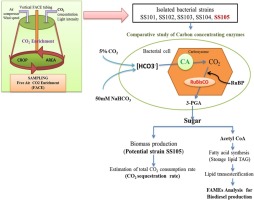Journal of CO2 Utilization ( IF 7.2 ) Pub Date : 2018-08-30 , DOI: 10.1016/j.jcou.2018.08.010 Neha Maheshwari , Madan Kumar , Indu Shekhar Thakur , Shaili Srivastava

|
Microbial CO2 fixation is an emerging strategy to mitigate CO2 emissions and its transformation into value added products by exploring potential bacteria. In this study, bacterial strains were isolated from Free Air CO2 Enrichment (FACE) soil area and screened for carbon dioxide sequestration and lipid production. CO2 sequestration efficiency of bacterial strains was determined via enzymatic activity of carbonic anhydrase (CA) and ribulose-1, 5-bisphosphate carboxylase/oxygenase (RuBisCO) involved in carbon concentrating mechanism (CCM). Bacillus sp. SS105 was found to be the most efficient strain for CCM and showed maximum biomass productivity (381 mg l−1d−1), and CO2 consumption rate (287.21 mg l−1d−1). Western blot analysis confirmed the presence of RuBisCO large subunit in Bacillus sp. SS105. Further genes were amplified from SS105 genome using degenerate primers. Amplified gene sequences showed homology with CA and rbcL gene. Bacterium SS105 has shown higher lipid production as compared to other strains. The lipid yield increased 1.5-fold after optimization. The chemical structure and composition of Fatty acid methyl esters (FAMEs) were characterized by GC MS, FTIR and 1H NMR. Total FAMEs content was quantified as 120 mg l−1 and showed 51 % of saturated and 49% of unsaturated fatty acids. Among the FAMEs, palmitic (37.80 %) and oleic acid (37.88 %) were present in high proportion which is a prerequisite for good quality biodiesel. The study highlights the importance of Bacillus sp. SS105 in CO2sequestration and biodiesel production with potential future applications.
中文翻译:

富集空气的CO 2(FACE)细菌对二氧化碳的生物固定作用,用于生产生物柴油
固定微生物CO 2是通过探索潜在细菌来减轻CO 2排放并将其转化为增值产品的新兴策略。在这项研究中,从自由空气CO 2富集(FACE)土壤区域分离出细菌菌株,并筛选了二氧化碳的固存和脂质的产生。通过碳酸酐酶(CA)和参与碳浓缩机制(CCM)的核糖-1、5-双磷酸羧化酶/加氧酶(RuBisCO)的酶活性确定细菌菌株的CO 2螯合效率。芽孢杆菌属。发现SS105是CCM最有效的菌株,并显示出最大的生物量生产力(381 mg l -1 d-1)和CO 2消耗率(287.21 mg l -1 d -1)。蛋白质印迹分析证实了芽孢杆菌属中存在RuBisCO大亚基。SS105。使用简并引物从SS105基因组中扩增其他基因。扩增的基因序列显示出与CA和rbcL基因的同源性。与其他菌株相比,细菌SS105已显示出更高的脂质产生。优化后脂质产量增加了1.5倍。脂肪酸甲酯(FAME)的化学结构和组成通过GC MS,FTIR和1 H NMR表征。FAME的总含量定为120 mg l -1并显示出51%的饱和脂肪酸和49%的不饱和脂肪酸。在脂肪酸甲酯中,棕榈酸(37.80%)和油酸(37.88%)以高比例存在,这是高质量生物柴油的前提。该研究突出了芽孢杆菌的重要性。SS105在CO 2隔离和生物柴油生产中具有潜在的未来应用。











































 京公网安备 11010802027423号
京公网安备 11010802027423号